Business Structure and Functions of Toyota: An Organizational Analysis
VerifiedAdded on 2020/11/23
|11
|3041
|482
Report
AI Summary
This report provides a comprehensive analysis of Toyota's business structure, examining its organizational functions, objectives, and its position within the private sector. The report begins by defining different types of organizations (public, private, voluntary) and legal structures, with a specific focus on Toyota as a private limited company. It explores the size and scope of various organizations, including small, medium, and large public limited companies, and categorizes them based on their production sectors (primary, secondary, tertiary). The report then analyzes how Toyota's structure, size, and scope are linked to its business objectives, products, and services, emphasizing the influence of stakeholders and the dynamic nature of the business environment. Furthermore, the report explains the relationships between organizational functions (HR, marketing, finance, etc.) and how they contribute to Toyota's objectives and structure. It highlights how marketing strategies, financial management, and HR practices are implemented to achieve efficiency and maintain a competitive edge. The report concludes by discussing the advantages and disadvantages of the interrelationships between these functions and their impact on the organization's overall structure, providing a detailed overview of Toyota's business operations and strategies.
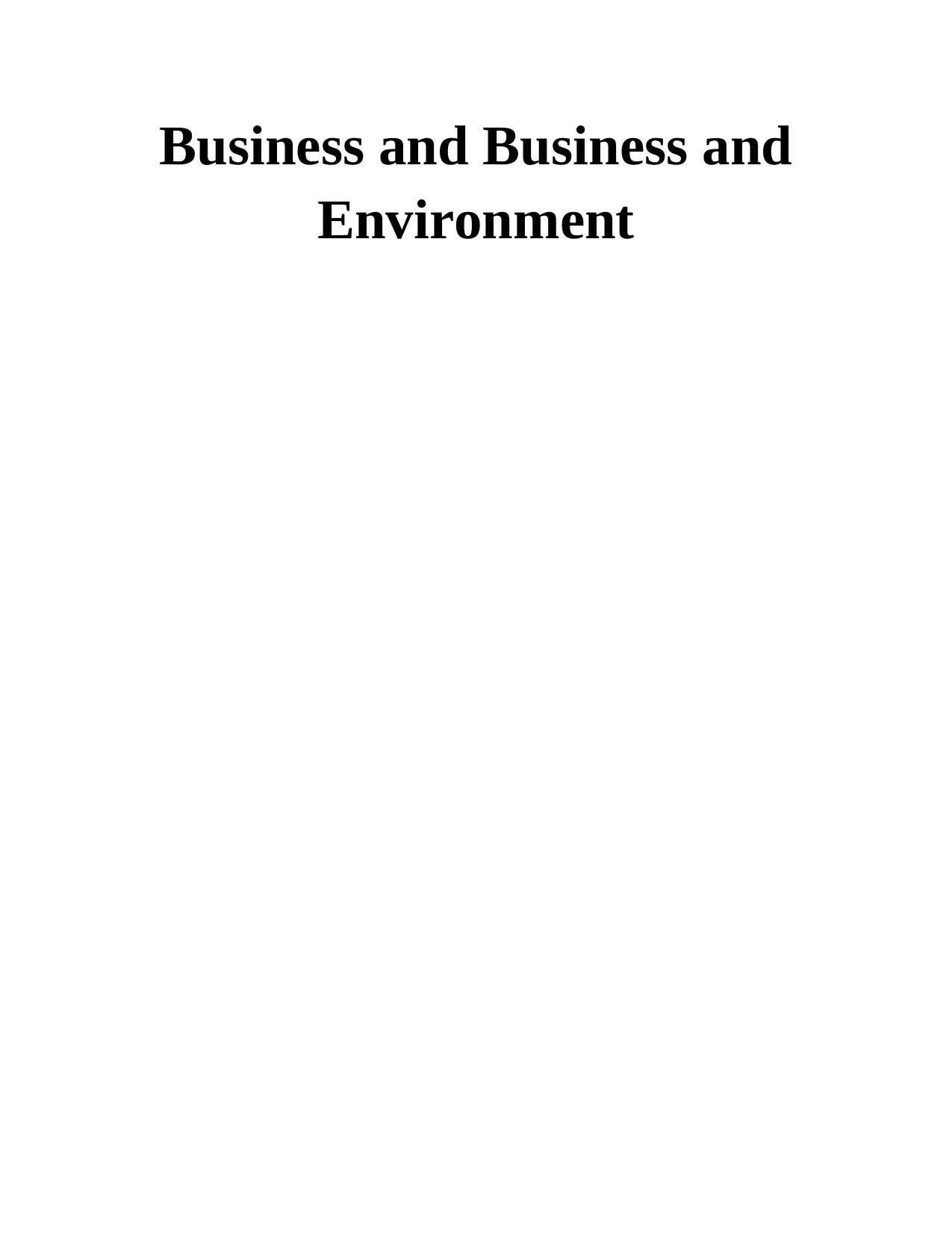
Business and Business and
Environment
Environment
Paraphrase This Document
Need a fresh take? Get an instant paraphrase of this document with our AI Paraphraser
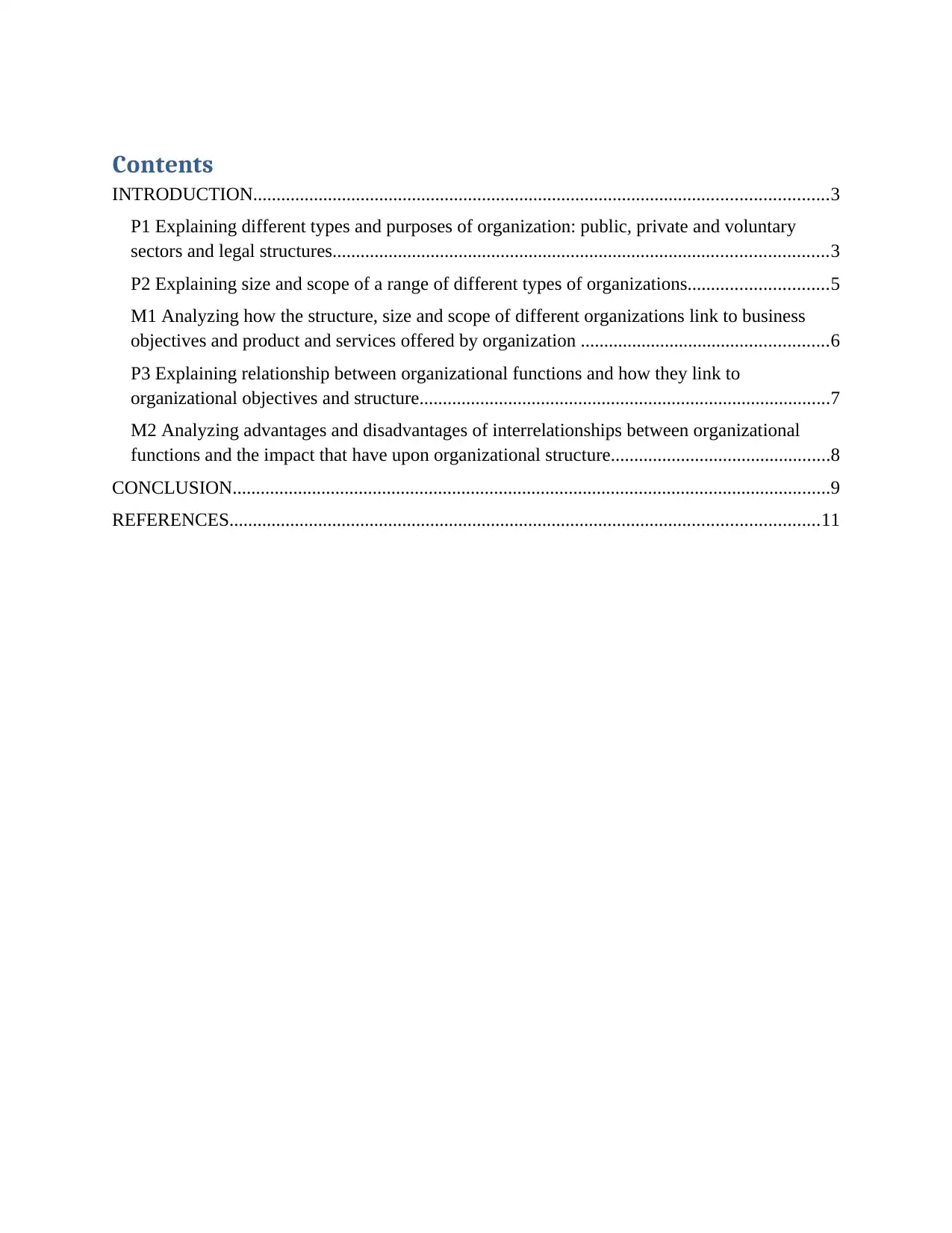
Contents
INTRODUCTION...........................................................................................................................3
P1 Explaining different types and purposes of organization: public, private and voluntary
sectors and legal structures..........................................................................................................3
P2 Explaining size and scope of a range of different types of organizations..............................5
M1 Analyzing how the structure, size and scope of different organizations link to business
objectives and product and services offered by organization .....................................................6
P3 Explaining relationship between organizational functions and how they link to
organizational objectives and structure........................................................................................7
M2 Analyzing advantages and disadvantages of interrelationships between organizational
functions and the impact that have upon organizational structure...............................................8
CONCLUSION................................................................................................................................9
REFERENCES..............................................................................................................................11
INTRODUCTION...........................................................................................................................3
P1 Explaining different types and purposes of organization: public, private and voluntary
sectors and legal structures..........................................................................................................3
P2 Explaining size and scope of a range of different types of organizations..............................5
M1 Analyzing how the structure, size and scope of different organizations link to business
objectives and product and services offered by organization .....................................................6
P3 Explaining relationship between organizational functions and how they link to
organizational objectives and structure........................................................................................7
M2 Analyzing advantages and disadvantages of interrelationships between organizational
functions and the impact that have upon organizational structure...............................................8
CONCLUSION................................................................................................................................9
REFERENCES..............................................................................................................................11
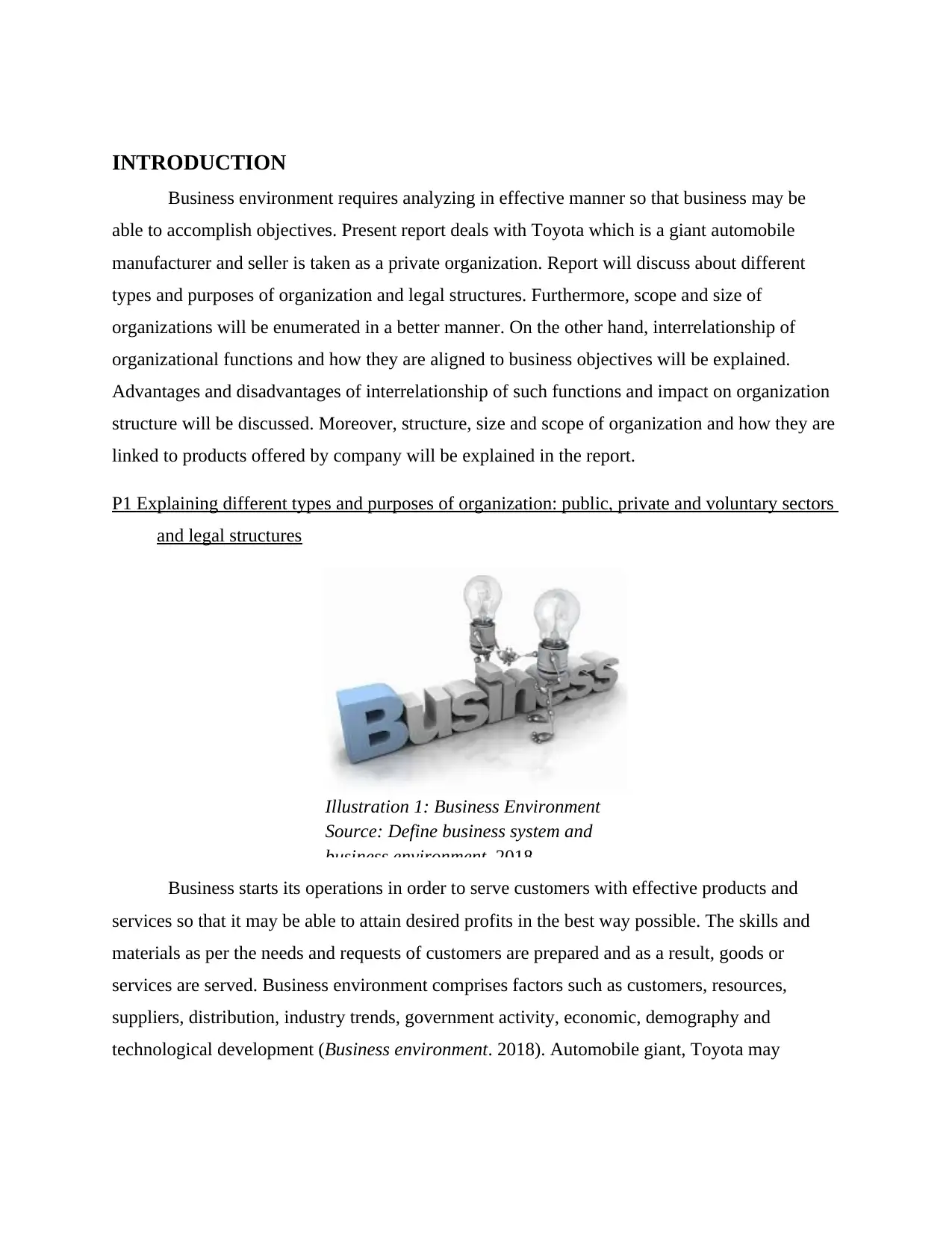
INTRODUCTION
Business environment requires analyzing in effective manner so that business may be
able to accomplish objectives. Present report deals with Toyota which is a giant automobile
manufacturer and seller is taken as a private organization. Report will discuss about different
types and purposes of organization and legal structures. Furthermore, scope and size of
organizations will be enumerated in a better manner. On the other hand, interrelationship of
organizational functions and how they are aligned to business objectives will be explained.
Advantages and disadvantages of interrelationship of such functions and impact on organization
structure will be discussed. Moreover, structure, size and scope of organization and how they are
linked to products offered by company will be explained in the report.
P1 Explaining different types and purposes of organization: public, private and voluntary sectors
and legal structures
Illustration 1: Business Environment
Source: Define business system and
business environment. 2018
Business starts its operations in order to serve customers with effective products and
services so that it may be able to attain desired profits in the best way possible. The skills and
materials as per the needs and requests of customers are prepared and as a result, goods or
services are served. Business environment comprises factors such as customers, resources,
suppliers, distribution, industry trends, government activity, economic, demography and
technological development (Business environment. 2018). Automobile giant, Toyota may
Business environment requires analyzing in effective manner so that business may be
able to accomplish objectives. Present report deals with Toyota which is a giant automobile
manufacturer and seller is taken as a private organization. Report will discuss about different
types and purposes of organization and legal structures. Furthermore, scope and size of
organizations will be enumerated in a better manner. On the other hand, interrelationship of
organizational functions and how they are aligned to business objectives will be explained.
Advantages and disadvantages of interrelationship of such functions and impact on organization
structure will be discussed. Moreover, structure, size and scope of organization and how they are
linked to products offered by company will be explained in the report.
P1 Explaining different types and purposes of organization: public, private and voluntary sectors
and legal structures
Illustration 1: Business Environment
Source: Define business system and
business environment. 2018
Business starts its operations in order to serve customers with effective products and
services so that it may be able to attain desired profits in the best way possible. The skills and
materials as per the needs and requests of customers are prepared and as a result, goods or
services are served. Business environment comprises factors such as customers, resources,
suppliers, distribution, industry trends, government activity, economic, demography and
technological development (Business environment. 2018). Automobile giant, Toyota may
⊘ This is a preview!⊘
Do you want full access?
Subscribe today to unlock all pages.

Trusted by 1+ million students worldwide
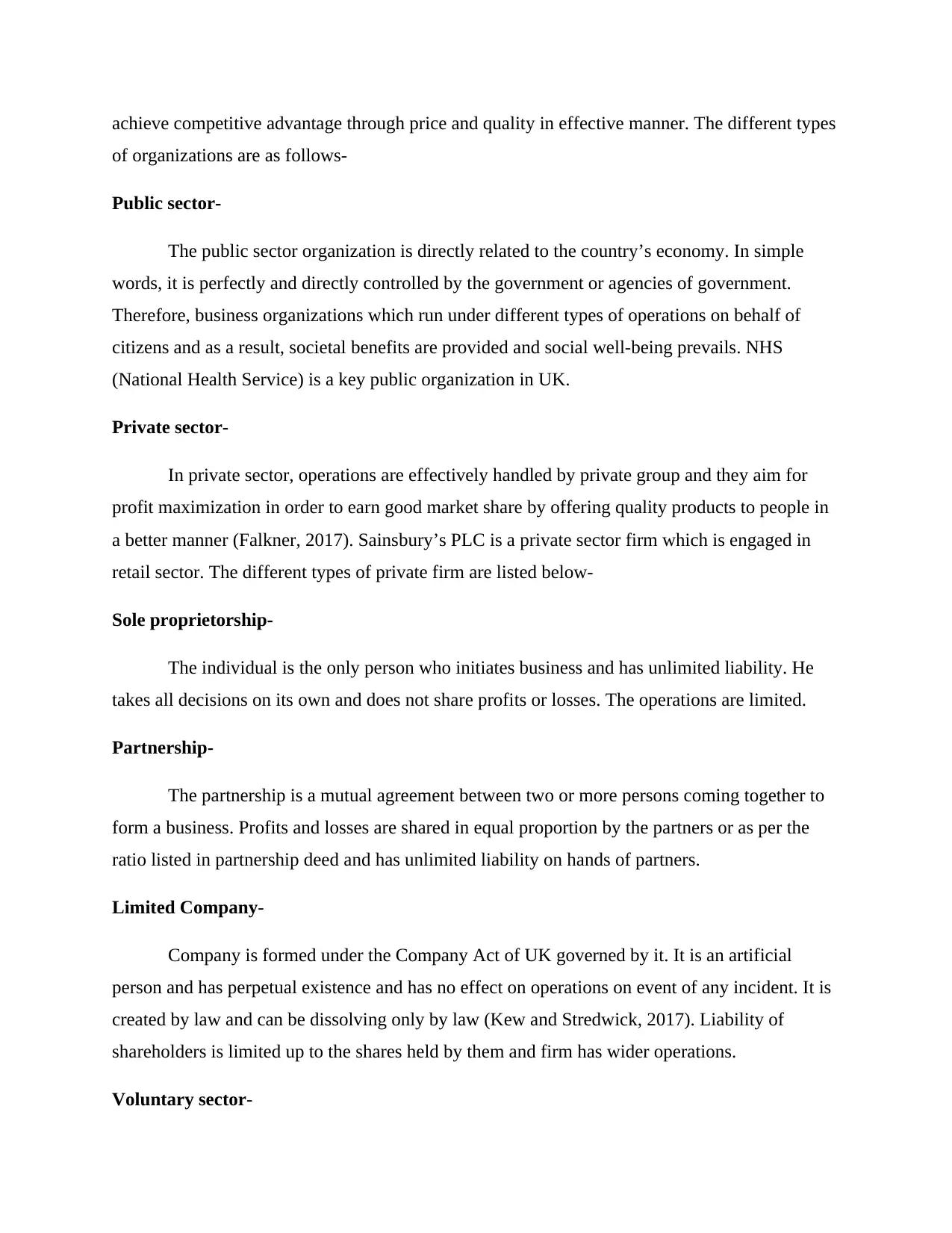
achieve competitive advantage through price and quality in effective manner. The different types
of organizations are as follows-
Public sector-
The public sector organization is directly related to the country’s economy. In simple
words, it is perfectly and directly controlled by the government or agencies of government.
Therefore, business organizations which run under different types of operations on behalf of
citizens and as a result, societal benefits are provided and social well-being prevails. NHS
(National Health Service) is a key public organization in UK.
Private sector-
In private sector, operations are effectively handled by private group and they aim for
profit maximization in order to earn good market share by offering quality products to people in
a better manner (Falkner, 2017). Sainsbury’s PLC is a private sector firm which is engaged in
retail sector. The different types of private firm are listed below-
Sole proprietorship-
The individual is the only person who initiates business and has unlimited liability. He
takes all decisions on its own and does not share profits or losses. The operations are limited.
Partnership-
The partnership is a mutual agreement between two or more persons coming together to
form a business. Profits and losses are shared in equal proportion by the partners or as per the
ratio listed in partnership deed and has unlimited liability on hands of partners.
Limited Company-
Company is formed under the Company Act of UK governed by it. It is an artificial
person and has perpetual existence and has no effect on operations on event of any incident. It is
created by law and can be dissolving only by law (Kew and Stredwick, 2017). Liability of
shareholders is limited up to the shares held by them and firm has wider operations.
Voluntary sector-
of organizations are as follows-
Public sector-
The public sector organization is directly related to the country’s economy. In simple
words, it is perfectly and directly controlled by the government or agencies of government.
Therefore, business organizations which run under different types of operations on behalf of
citizens and as a result, societal benefits are provided and social well-being prevails. NHS
(National Health Service) is a key public organization in UK.
Private sector-
In private sector, operations are effectively handled by private group and they aim for
profit maximization in order to earn good market share by offering quality products to people in
a better manner (Falkner, 2017). Sainsbury’s PLC is a private sector firm which is engaged in
retail sector. The different types of private firm are listed below-
Sole proprietorship-
The individual is the only person who initiates business and has unlimited liability. He
takes all decisions on its own and does not share profits or losses. The operations are limited.
Partnership-
The partnership is a mutual agreement between two or more persons coming together to
form a business. Profits and losses are shared in equal proportion by the partners or as per the
ratio listed in partnership deed and has unlimited liability on hands of partners.
Limited Company-
Company is formed under the Company Act of UK governed by it. It is an artificial
person and has perpetual existence and has no effect on operations on event of any incident. It is
created by law and can be dissolving only by law (Kew and Stredwick, 2017). Liability of
shareholders is limited up to the shares held by them and firm has wider operations.
Voluntary sector-
Paraphrase This Document
Need a fresh take? Get an instant paraphrase of this document with our AI Paraphraser
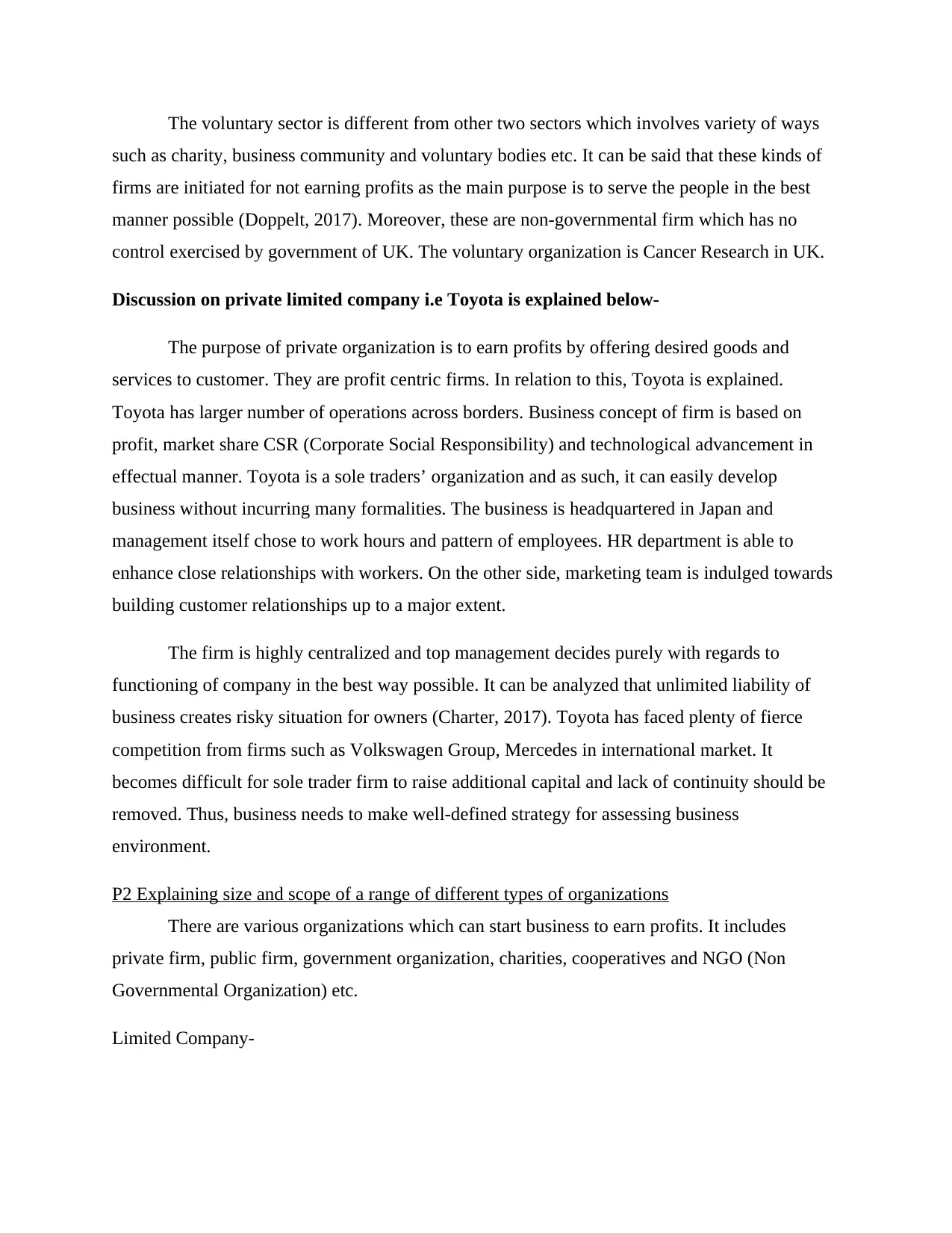
The voluntary sector is different from other two sectors which involves variety of ways
such as charity, business community and voluntary bodies etc. It can be said that these kinds of
firms are initiated for not earning profits as the main purpose is to serve the people in the best
manner possible (Doppelt, 2017). Moreover, these are non-governmental firm which has no
control exercised by government of UK. The voluntary organization is Cancer Research in UK.
Discussion on private limited company i.e Toyota is explained below-
The purpose of private organization is to earn profits by offering desired goods and
services to customer. They are profit centric firms. In relation to this, Toyota is explained.
Toyota has larger number of operations across borders. Business concept of firm is based on
profit, market share CSR (Corporate Social Responsibility) and technological advancement in
effectual manner. Toyota is a sole traders’ organization and as such, it can easily develop
business without incurring many formalities. The business is headquartered in Japan and
management itself chose to work hours and pattern of employees. HR department is able to
enhance close relationships with workers. On the other side, marketing team is indulged towards
building customer relationships up to a major extent.
The firm is highly centralized and top management decides purely with regards to
functioning of company in the best way possible. It can be analyzed that unlimited liability of
business creates risky situation for owners (Charter, 2017). Toyota has faced plenty of fierce
competition from firms such as Volkswagen Group, Mercedes in international market. It
becomes difficult for sole trader firm to raise additional capital and lack of continuity should be
removed. Thus, business needs to make well-defined strategy for assessing business
environment.
P2 Explaining size and scope of a range of different types of organizations
There are various organizations which can start business to earn profits. It includes
private firm, public firm, government organization, charities, cooperatives and NGO (Non
Governmental Organization) etc.
Limited Company-
such as charity, business community and voluntary bodies etc. It can be said that these kinds of
firms are initiated for not earning profits as the main purpose is to serve the people in the best
manner possible (Doppelt, 2017). Moreover, these are non-governmental firm which has no
control exercised by government of UK. The voluntary organization is Cancer Research in UK.
Discussion on private limited company i.e Toyota is explained below-
The purpose of private organization is to earn profits by offering desired goods and
services to customer. They are profit centric firms. In relation to this, Toyota is explained.
Toyota has larger number of operations across borders. Business concept of firm is based on
profit, market share CSR (Corporate Social Responsibility) and technological advancement in
effectual manner. Toyota is a sole traders’ organization and as such, it can easily develop
business without incurring many formalities. The business is headquartered in Japan and
management itself chose to work hours and pattern of employees. HR department is able to
enhance close relationships with workers. On the other side, marketing team is indulged towards
building customer relationships up to a major extent.
The firm is highly centralized and top management decides purely with regards to
functioning of company in the best way possible. It can be analyzed that unlimited liability of
business creates risky situation for owners (Charter, 2017). Toyota has faced plenty of fierce
competition from firms such as Volkswagen Group, Mercedes in international market. It
becomes difficult for sole trader firm to raise additional capital and lack of continuity should be
removed. Thus, business needs to make well-defined strategy for assessing business
environment.
P2 Explaining size and scope of a range of different types of organizations
There are various organizations which can start business to earn profits. It includes
private firm, public firm, government organization, charities, cooperatives and NGO (Non
Governmental Organization) etc.
Limited Company-
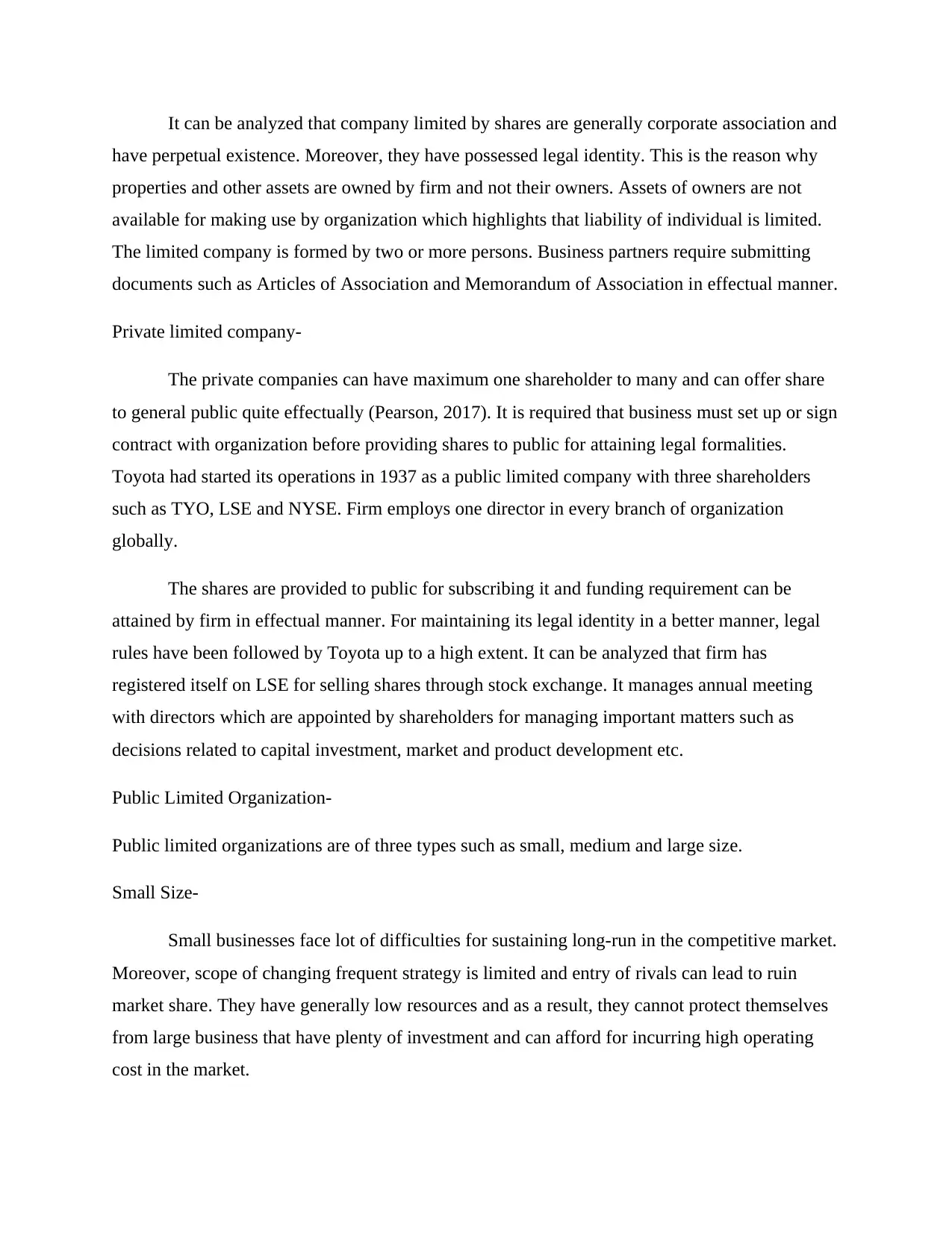
It can be analyzed that company limited by shares are generally corporate association and
have perpetual existence. Moreover, they have possessed legal identity. This is the reason why
properties and other assets are owned by firm and not their owners. Assets of owners are not
available for making use by organization which highlights that liability of individual is limited.
The limited company is formed by two or more persons. Business partners require submitting
documents such as Articles of Association and Memorandum of Association in effectual manner.
Private limited company-
The private companies can have maximum one shareholder to many and can offer share
to general public quite effectually (Pearson, 2017). It is required that business must set up or sign
contract with organization before providing shares to public for attaining legal formalities.
Toyota had started its operations in 1937 as a public limited company with three shareholders
such as TYO, LSE and NYSE. Firm employs one director in every branch of organization
globally.
The shares are provided to public for subscribing it and funding requirement can be
attained by firm in effectual manner. For maintaining its legal identity in a better manner, legal
rules have been followed by Toyota up to a high extent. It can be analyzed that firm has
registered itself on LSE for selling shares through stock exchange. It manages annual meeting
with directors which are appointed by shareholders for managing important matters such as
decisions related to capital investment, market and product development etc.
Public Limited Organization-
Public limited organizations are of three types such as small, medium and large size.
Small Size-
Small businesses face lot of difficulties for sustaining long-run in the competitive market.
Moreover, scope of changing frequent strategy is limited and entry of rivals can lead to ruin
market share. They have generally low resources and as a result, they cannot protect themselves
from large business that have plenty of investment and can afford for incurring high operating
cost in the market.
have perpetual existence. Moreover, they have possessed legal identity. This is the reason why
properties and other assets are owned by firm and not their owners. Assets of owners are not
available for making use by organization which highlights that liability of individual is limited.
The limited company is formed by two or more persons. Business partners require submitting
documents such as Articles of Association and Memorandum of Association in effectual manner.
Private limited company-
The private companies can have maximum one shareholder to many and can offer share
to general public quite effectually (Pearson, 2017). It is required that business must set up or sign
contract with organization before providing shares to public for attaining legal formalities.
Toyota had started its operations in 1937 as a public limited company with three shareholders
such as TYO, LSE and NYSE. Firm employs one director in every branch of organization
globally.
The shares are provided to public for subscribing it and funding requirement can be
attained by firm in effectual manner. For maintaining its legal identity in a better manner, legal
rules have been followed by Toyota up to a high extent. It can be analyzed that firm has
registered itself on LSE for selling shares through stock exchange. It manages annual meeting
with directors which are appointed by shareholders for managing important matters such as
decisions related to capital investment, market and product development etc.
Public Limited Organization-
Public limited organizations are of three types such as small, medium and large size.
Small Size-
Small businesses face lot of difficulties for sustaining long-run in the competitive market.
Moreover, scope of changing frequent strategy is limited and entry of rivals can lead to ruin
market share. They have generally low resources and as a result, they cannot protect themselves
from large business that have plenty of investment and can afford for incurring high operating
cost in the market.
⊘ This is a preview!⊘
Do you want full access?
Subscribe today to unlock all pages.

Trusted by 1+ million students worldwide
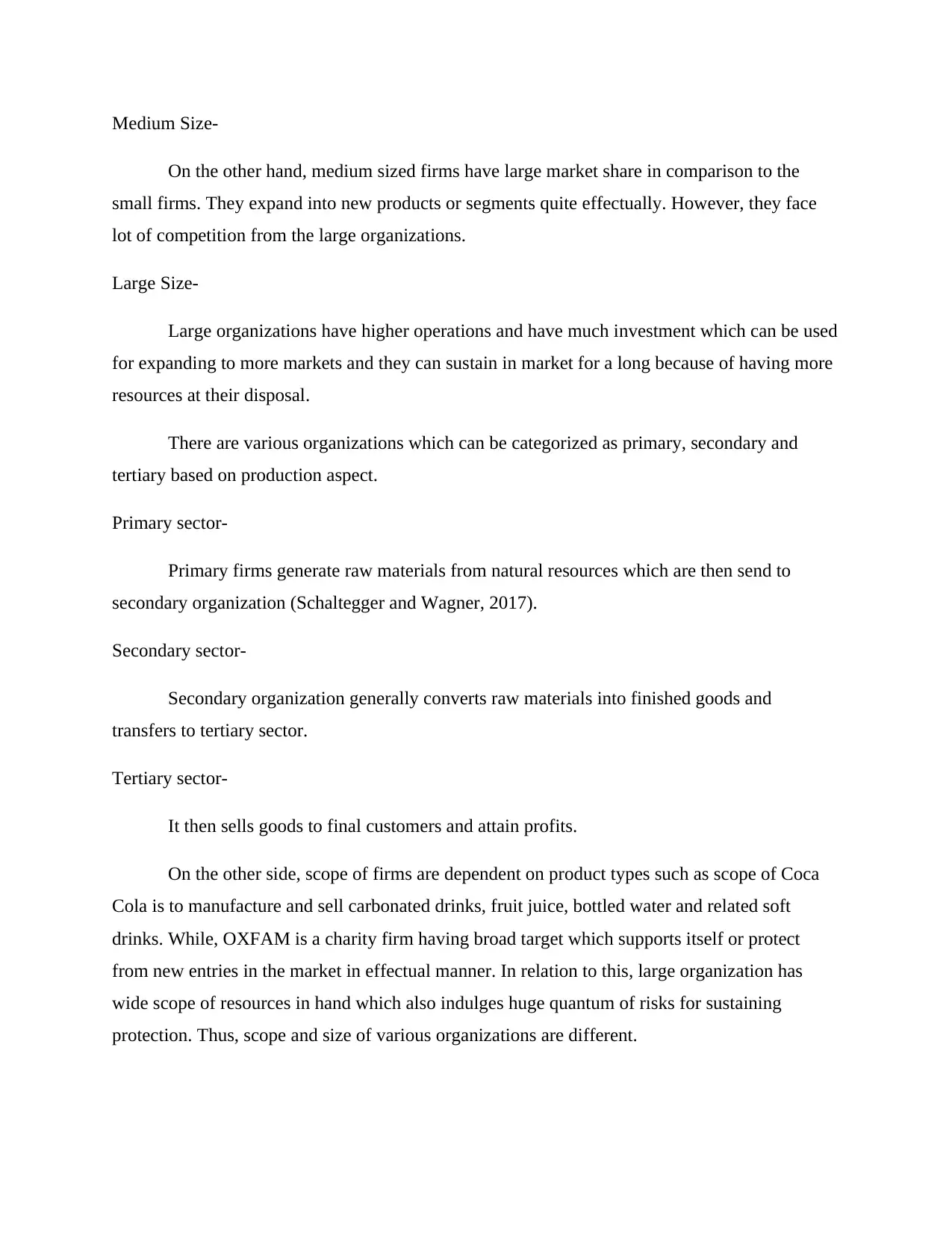
Medium Size-
On the other hand, medium sized firms have large market share in comparison to the
small firms. They expand into new products or segments quite effectually. However, they face
lot of competition from the large organizations.
Large Size-
Large organizations have higher operations and have much investment which can be used
for expanding to more markets and they can sustain in market for a long because of having more
resources at their disposal.
There are various organizations which can be categorized as primary, secondary and
tertiary based on production aspect.
Primary sector-
Primary firms generate raw materials from natural resources which are then send to
secondary organization (Schaltegger and Wagner, 2017).
Secondary sector-
Secondary organization generally converts raw materials into finished goods and
transfers to tertiary sector.
Tertiary sector-
It then sells goods to final customers and attain profits.
On the other side, scope of firms are dependent on product types such as scope of Coca
Cola is to manufacture and sell carbonated drinks, fruit juice, bottled water and related soft
drinks. While, OXFAM is a charity firm having broad target which supports itself or protect
from new entries in the market in effectual manner. In relation to this, large organization has
wide scope of resources in hand which also indulges huge quantum of risks for sustaining
protection. Thus, scope and size of various organizations are different.
On the other hand, medium sized firms have large market share in comparison to the
small firms. They expand into new products or segments quite effectually. However, they face
lot of competition from the large organizations.
Large Size-
Large organizations have higher operations and have much investment which can be used
for expanding to more markets and they can sustain in market for a long because of having more
resources at their disposal.
There are various organizations which can be categorized as primary, secondary and
tertiary based on production aspect.
Primary sector-
Primary firms generate raw materials from natural resources which are then send to
secondary organization (Schaltegger and Wagner, 2017).
Secondary sector-
Secondary organization generally converts raw materials into finished goods and
transfers to tertiary sector.
Tertiary sector-
It then sells goods to final customers and attain profits.
On the other side, scope of firms are dependent on product types such as scope of Coca
Cola is to manufacture and sell carbonated drinks, fruit juice, bottled water and related soft
drinks. While, OXFAM is a charity firm having broad target which supports itself or protect
from new entries in the market in effectual manner. In relation to this, large organization has
wide scope of resources in hand which also indulges huge quantum of risks for sustaining
protection. Thus, scope and size of various organizations are different.
Paraphrase This Document
Need a fresh take? Get an instant paraphrase of this document with our AI Paraphraser
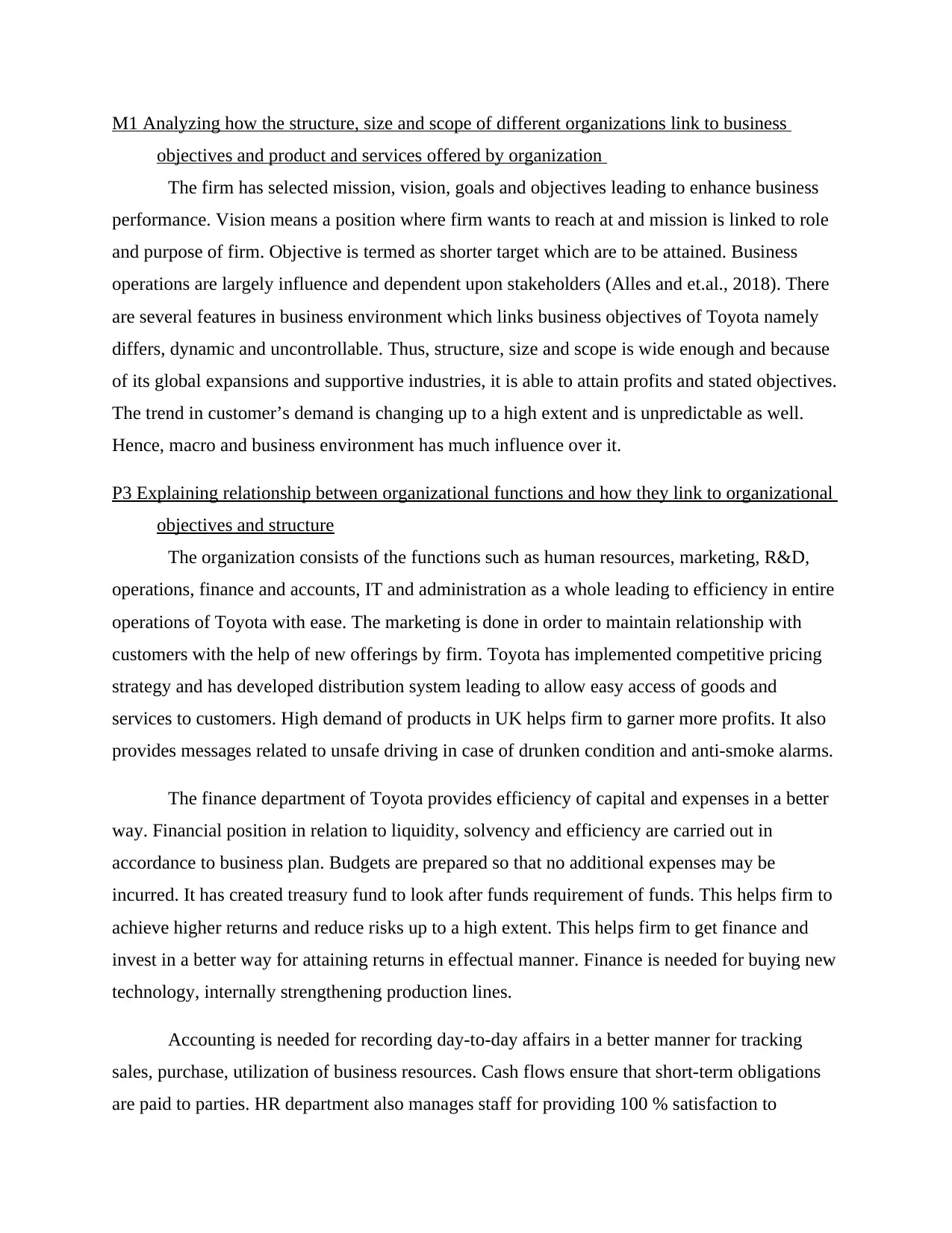
M1 Analyzing how the structure, size and scope of different organizations link to business
objectives and product and services offered by organization
The firm has selected mission, vision, goals and objectives leading to enhance business
performance. Vision means a position where firm wants to reach at and mission is linked to role
and purpose of firm. Objective is termed as shorter target which are to be attained. Business
operations are largely influence and dependent upon stakeholders (Alles and et.al., 2018). There
are several features in business environment which links business objectives of Toyota namely
differs, dynamic and uncontrollable. Thus, structure, size and scope is wide enough and because
of its global expansions and supportive industries, it is able to attain profits and stated objectives.
The trend in customer’s demand is changing up to a high extent and is unpredictable as well.
Hence, macro and business environment has much influence over it.
P3 Explaining relationship between organizational functions and how they link to organizational
objectives and structure
The organization consists of the functions such as human resources, marketing, R&D,
operations, finance and accounts, IT and administration as a whole leading to efficiency in entire
operations of Toyota with ease. The marketing is done in order to maintain relationship with
customers with the help of new offerings by firm. Toyota has implemented competitive pricing
strategy and has developed distribution system leading to allow easy access of goods and
services to customers. High demand of products in UK helps firm to garner more profits. It also
provides messages related to unsafe driving in case of drunken condition and anti-smoke alarms.
The finance department of Toyota provides efficiency of capital and expenses in a better
way. Financial position in relation to liquidity, solvency and efficiency are carried out in
accordance to business plan. Budgets are prepared so that no additional expenses may be
incurred. It has created treasury fund to look after funds requirement of funds. This helps firm to
achieve higher returns and reduce risks up to a high extent. This helps firm to get finance and
invest in a better way for attaining returns in effectual manner. Finance is needed for buying new
technology, internally strengthening production lines.
Accounting is needed for recording day-to-day affairs in a better manner for tracking
sales, purchase, utilization of business resources. Cash flows ensure that short-term obligations
are paid to parties. HR department also manages staff for providing 100 % satisfaction to
objectives and product and services offered by organization
The firm has selected mission, vision, goals and objectives leading to enhance business
performance. Vision means a position where firm wants to reach at and mission is linked to role
and purpose of firm. Objective is termed as shorter target which are to be attained. Business
operations are largely influence and dependent upon stakeholders (Alles and et.al., 2018). There
are several features in business environment which links business objectives of Toyota namely
differs, dynamic and uncontrollable. Thus, structure, size and scope is wide enough and because
of its global expansions and supportive industries, it is able to attain profits and stated objectives.
The trend in customer’s demand is changing up to a high extent and is unpredictable as well.
Hence, macro and business environment has much influence over it.
P3 Explaining relationship between organizational functions and how they link to organizational
objectives and structure
The organization consists of the functions such as human resources, marketing, R&D,
operations, finance and accounts, IT and administration as a whole leading to efficiency in entire
operations of Toyota with ease. The marketing is done in order to maintain relationship with
customers with the help of new offerings by firm. Toyota has implemented competitive pricing
strategy and has developed distribution system leading to allow easy access of goods and
services to customers. High demand of products in UK helps firm to garner more profits. It also
provides messages related to unsafe driving in case of drunken condition and anti-smoke alarms.
The finance department of Toyota provides efficiency of capital and expenses in a better
way. Financial position in relation to liquidity, solvency and efficiency are carried out in
accordance to business plan. Budgets are prepared so that no additional expenses may be
incurred. It has created treasury fund to look after funds requirement of funds. This helps firm to
achieve higher returns and reduce risks up to a high extent. This helps firm to get finance and
invest in a better way for attaining returns in effectual manner. Finance is needed for buying new
technology, internally strengthening production lines.
Accounting is needed for recording day-to-day affairs in a better manner for tracking
sales, purchase, utilization of business resources. Cash flows ensure that short-term obligations
are paid to parties. HR department also manages staff for providing 100 % satisfaction to
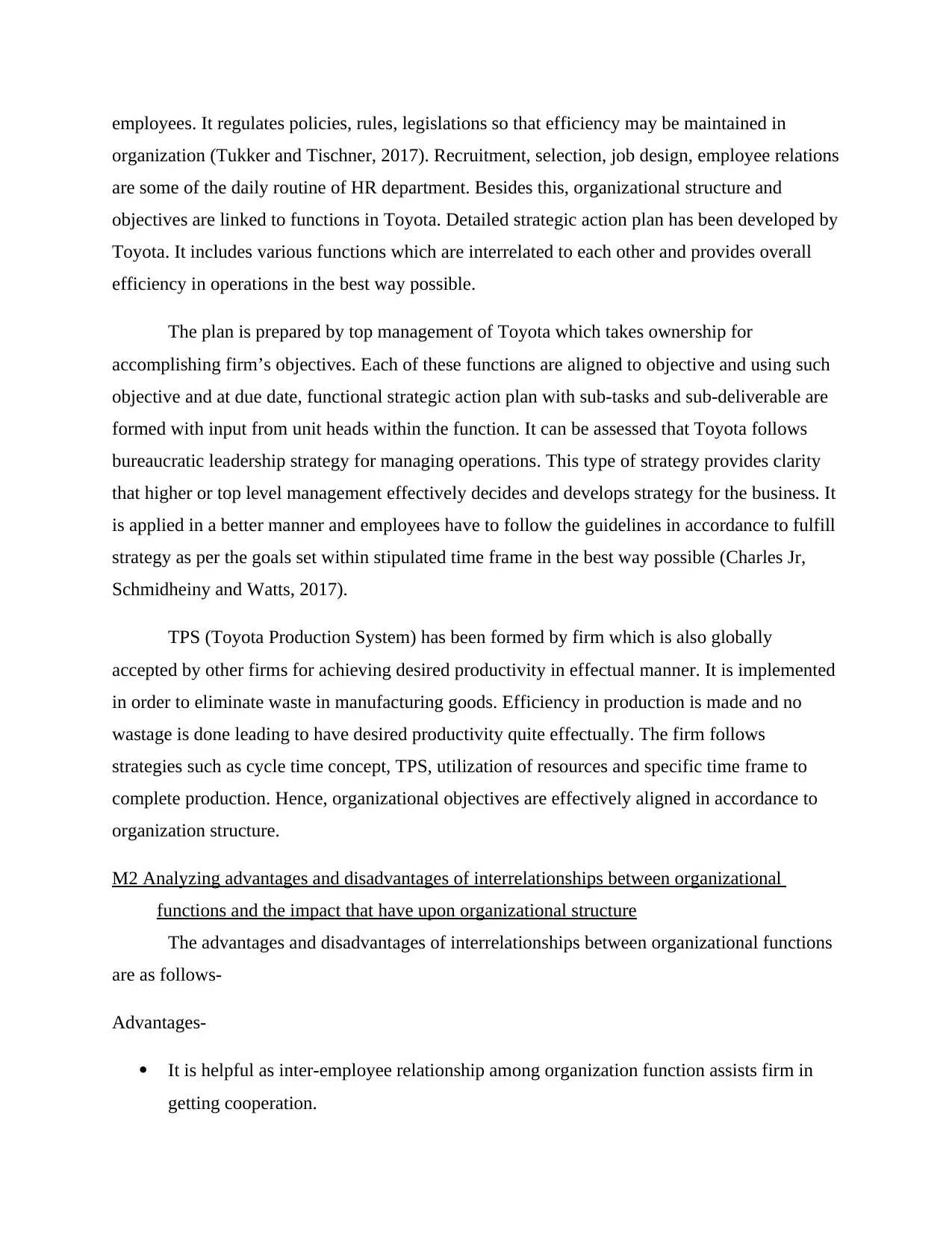
employees. It regulates policies, rules, legislations so that efficiency may be maintained in
organization (Tukker and Tischner, 2017). Recruitment, selection, job design, employee relations
are some of the daily routine of HR department. Besides this, organizational structure and
objectives are linked to functions in Toyota. Detailed strategic action plan has been developed by
Toyota. It includes various functions which are interrelated to each other and provides overall
efficiency in operations in the best way possible.
The plan is prepared by top management of Toyota which takes ownership for
accomplishing firm’s objectives. Each of these functions are aligned to objective and using such
objective and at due date, functional strategic action plan with sub-tasks and sub-deliverable are
formed with input from unit heads within the function. It can be assessed that Toyota follows
bureaucratic leadership strategy for managing operations. This type of strategy provides clarity
that higher or top level management effectively decides and develops strategy for the business. It
is applied in a better manner and employees have to follow the guidelines in accordance to fulfill
strategy as per the goals set within stipulated time frame in the best way possible (Charles Jr,
Schmidheiny and Watts, 2017).
TPS (Toyota Production System) has been formed by firm which is also globally
accepted by other firms for achieving desired productivity in effectual manner. It is implemented
in order to eliminate waste in manufacturing goods. Efficiency in production is made and no
wastage is done leading to have desired productivity quite effectually. The firm follows
strategies such as cycle time concept, TPS, utilization of resources and specific time frame to
complete production. Hence, organizational objectives are effectively aligned in accordance to
organization structure.
M2 Analyzing advantages and disadvantages of interrelationships between organizational
functions and the impact that have upon organizational structure
The advantages and disadvantages of interrelationships between organizational functions
are as follows-
Advantages-
It is helpful as inter-employee relationship among organization function assists firm in
getting cooperation.
organization (Tukker and Tischner, 2017). Recruitment, selection, job design, employee relations
are some of the daily routine of HR department. Besides this, organizational structure and
objectives are linked to functions in Toyota. Detailed strategic action plan has been developed by
Toyota. It includes various functions which are interrelated to each other and provides overall
efficiency in operations in the best way possible.
The plan is prepared by top management of Toyota which takes ownership for
accomplishing firm’s objectives. Each of these functions are aligned to objective and using such
objective and at due date, functional strategic action plan with sub-tasks and sub-deliverable are
formed with input from unit heads within the function. It can be assessed that Toyota follows
bureaucratic leadership strategy for managing operations. This type of strategy provides clarity
that higher or top level management effectively decides and develops strategy for the business. It
is applied in a better manner and employees have to follow the guidelines in accordance to fulfill
strategy as per the goals set within stipulated time frame in the best way possible (Charles Jr,
Schmidheiny and Watts, 2017).
TPS (Toyota Production System) has been formed by firm which is also globally
accepted by other firms for achieving desired productivity in effectual manner. It is implemented
in order to eliminate waste in manufacturing goods. Efficiency in production is made and no
wastage is done leading to have desired productivity quite effectually. The firm follows
strategies such as cycle time concept, TPS, utilization of resources and specific time frame to
complete production. Hence, organizational objectives are effectively aligned in accordance to
organization structure.
M2 Analyzing advantages and disadvantages of interrelationships between organizational
functions and the impact that have upon organizational structure
The advantages and disadvantages of interrelationships between organizational functions
are as follows-
Advantages-
It is helpful as inter-employee relationship among organization function assists firm in
getting cooperation.
⊘ This is a preview!⊘
Do you want full access?
Subscribe today to unlock all pages.

Trusted by 1+ million students worldwide
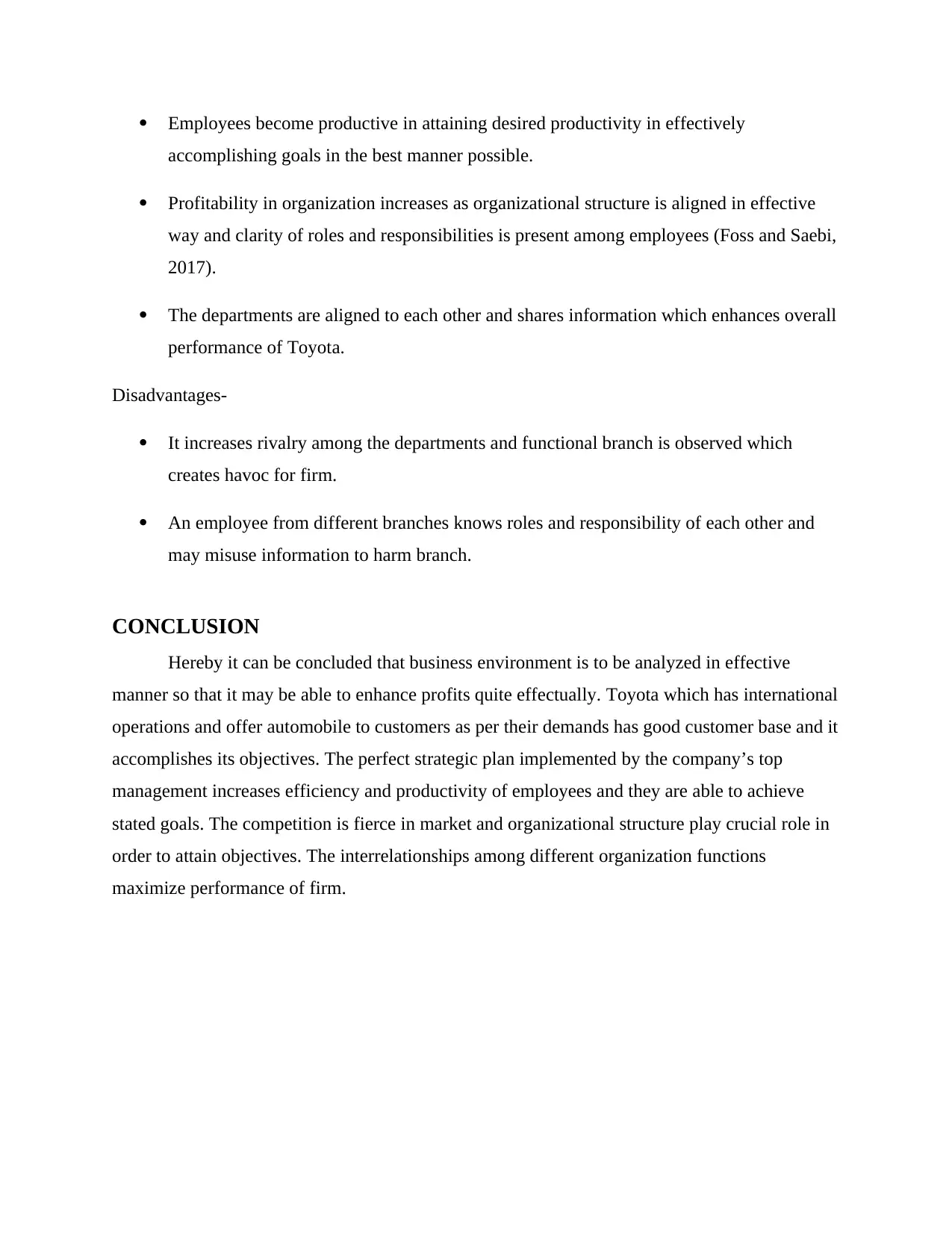
Employees become productive in attaining desired productivity in effectively
accomplishing goals in the best manner possible.
Profitability in organization increases as organizational structure is aligned in effective
way and clarity of roles and responsibilities is present among employees (Foss and Saebi,
2017).
The departments are aligned to each other and shares information which enhances overall
performance of Toyota.
Disadvantages-
It increases rivalry among the departments and functional branch is observed which
creates havoc for firm.
An employee from different branches knows roles and responsibility of each other and
may misuse information to harm branch.
CONCLUSION
Hereby it can be concluded that business environment is to be analyzed in effective
manner so that it may be able to enhance profits quite effectually. Toyota which has international
operations and offer automobile to customers as per their demands has good customer base and it
accomplishes its objectives. The perfect strategic plan implemented by the company’s top
management increases efficiency and productivity of employees and they are able to achieve
stated goals. The competition is fierce in market and organizational structure play crucial role in
order to attain objectives. The interrelationships among different organization functions
maximize performance of firm.
accomplishing goals in the best manner possible.
Profitability in organization increases as organizational structure is aligned in effective
way and clarity of roles and responsibilities is present among employees (Foss and Saebi,
2017).
The departments are aligned to each other and shares information which enhances overall
performance of Toyota.
Disadvantages-
It increases rivalry among the departments and functional branch is observed which
creates havoc for firm.
An employee from different branches knows roles and responsibility of each other and
may misuse information to harm branch.
CONCLUSION
Hereby it can be concluded that business environment is to be analyzed in effective
manner so that it may be able to enhance profits quite effectually. Toyota which has international
operations and offer automobile to customers as per their demands has good customer base and it
accomplishes its objectives. The perfect strategic plan implemented by the company’s top
management increases efficiency and productivity of employees and they are able to achieve
stated goals. The competition is fierce in market and organizational structure play crucial role in
order to attain objectives. The interrelationships among different organization functions
maximize performance of firm.
Paraphrase This Document
Need a fresh take? Get an instant paraphrase of this document with our AI Paraphraser
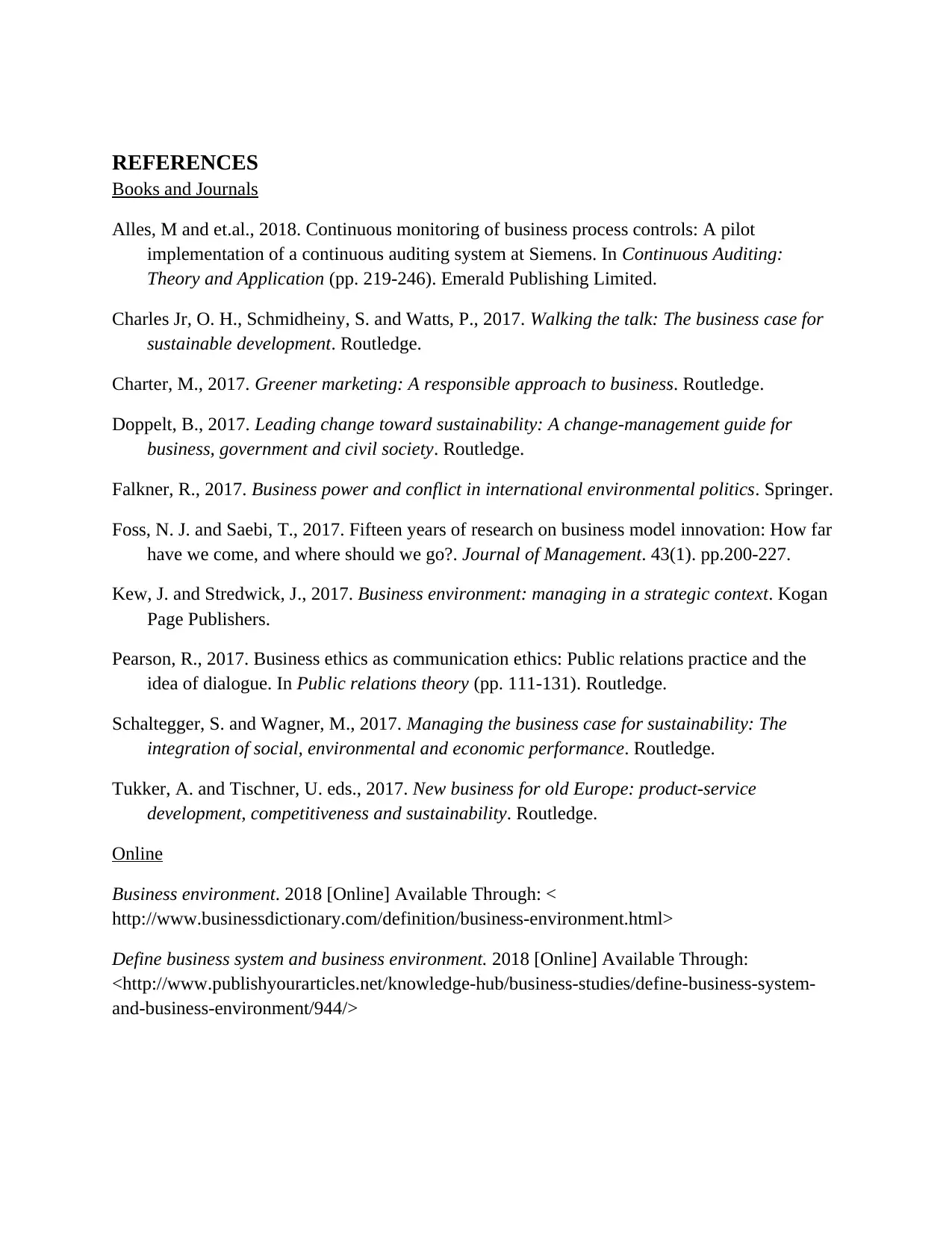
REFERENCES
Books and Journals
Alles, M and et.al., 2018. Continuous monitoring of business process controls: A pilot
implementation of a continuous auditing system at Siemens. In Continuous Auditing:
Theory and Application (pp. 219-246). Emerald Publishing Limited.
Charles Jr, O. H., Schmidheiny, S. and Watts, P., 2017. Walking the talk: The business case for
sustainable development. Routledge.
Charter, M., 2017. Greener marketing: A responsible approach to business. Routledge.
Doppelt, B., 2017. Leading change toward sustainability: A change-management guide for
business, government and civil society. Routledge.
Falkner, R., 2017. Business power and conflict in international environmental politics. Springer.
Foss, N. J. and Saebi, T., 2017. Fifteen years of research on business model innovation: How far
have we come, and where should we go?. Journal of Management. 43(1). pp.200-227.
Kew, J. and Stredwick, J., 2017. Business environment: managing in a strategic context. Kogan
Page Publishers.
Pearson, R., 2017. Business ethics as communication ethics: Public relations practice and the
idea of dialogue. In Public relations theory (pp. 111-131). Routledge.
Schaltegger, S. and Wagner, M., 2017. Managing the business case for sustainability: The
integration of social, environmental and economic performance. Routledge.
Tukker, A. and Tischner, U. eds., 2017. New business for old Europe: product-service
development, competitiveness and sustainability. Routledge.
Online
Business environment. 2018 [Online] Available Through: <
http://www.businessdictionary.com/definition/business-environment.html>
Define business system and business environment. 2018 [Online] Available Through:
<http://www.publishyourarticles.net/knowledge-hub/business-studies/define-business-system-
and-business-environment/944/>
Books and Journals
Alles, M and et.al., 2018. Continuous monitoring of business process controls: A pilot
implementation of a continuous auditing system at Siemens. In Continuous Auditing:
Theory and Application (pp. 219-246). Emerald Publishing Limited.
Charles Jr, O. H., Schmidheiny, S. and Watts, P., 2017. Walking the talk: The business case for
sustainable development. Routledge.
Charter, M., 2017. Greener marketing: A responsible approach to business. Routledge.
Doppelt, B., 2017. Leading change toward sustainability: A change-management guide for
business, government and civil society. Routledge.
Falkner, R., 2017. Business power and conflict in international environmental politics. Springer.
Foss, N. J. and Saebi, T., 2017. Fifteen years of research on business model innovation: How far
have we come, and where should we go?. Journal of Management. 43(1). pp.200-227.
Kew, J. and Stredwick, J., 2017. Business environment: managing in a strategic context. Kogan
Page Publishers.
Pearson, R., 2017. Business ethics as communication ethics: Public relations practice and the
idea of dialogue. In Public relations theory (pp. 111-131). Routledge.
Schaltegger, S. and Wagner, M., 2017. Managing the business case for sustainability: The
integration of social, environmental and economic performance. Routledge.
Tukker, A. and Tischner, U. eds., 2017. New business for old Europe: product-service
development, competitiveness and sustainability. Routledge.
Online
Business environment. 2018 [Online] Available Through: <
http://www.businessdictionary.com/definition/business-environment.html>
Define business system and business environment. 2018 [Online] Available Through:
<http://www.publishyourarticles.net/knowledge-hub/business-studies/define-business-system-
and-business-environment/944/>
1 out of 11
Related Documents
Your All-in-One AI-Powered Toolkit for Academic Success.
+13062052269
info@desklib.com
Available 24*7 on WhatsApp / Email
![[object Object]](/_next/static/media/star-bottom.7253800d.svg)
Unlock your academic potential
Copyright © 2020–2025 A2Z Services. All Rights Reserved. Developed and managed by ZUCOL.




